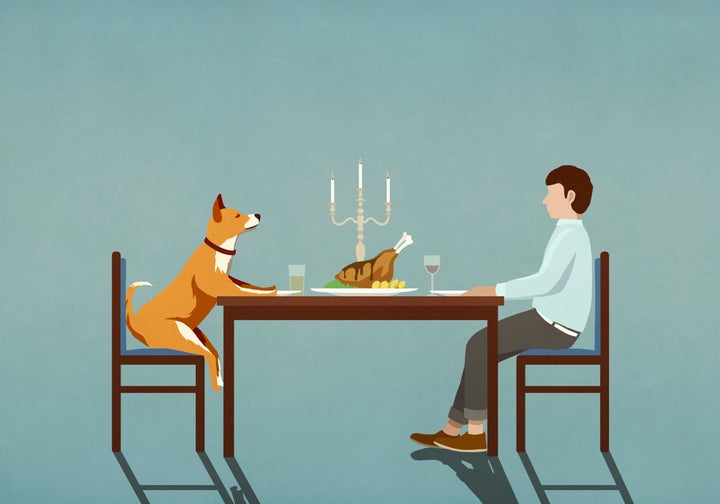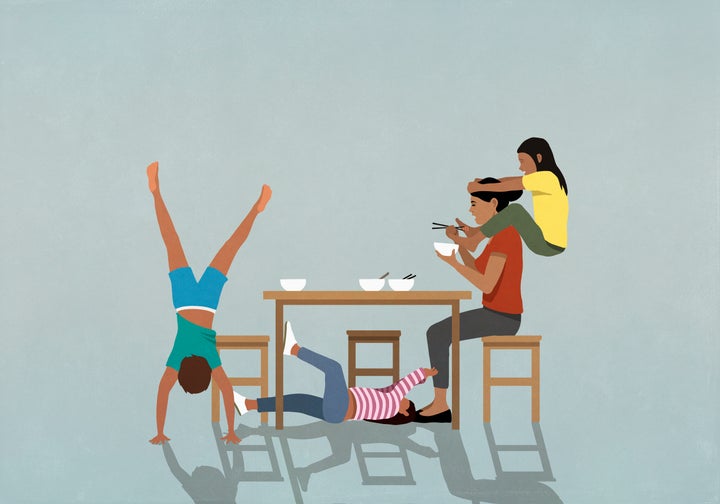
With more and more people working from home these days, balancing our personal and professional lives can be challenging, especially when it comes to family meals. And when most people picture a “family meal,” they imagine two parents at the heads of the table with several children gathered around. But oftentimes, that isn’t the case. Not all family meals necessarily look the same — but they’re all equally important.
A growing number of working professionals, undeterred by the distraction of culinary perfection, are actually enjoying the family meal with refreshing practicality, whether they’re feeding children, pets or their own parents. Here is a glimpse into just a few of those lives, as well as the impact behind sharing a simple meal.
Kristen Aiken, the senior editor of food and drink at HuffPost, first became interested in food during her job as a sports editor, when she realized she needed a way to unwind.
“The hours were long, and cooking was a de-stressor and a way to show people I cared about them when I wasn’t comfortable saying it out loud,” Aiken said. She eventually went on to change careers and graduated from the French Culinary Institute before becoming a food editor for Martha Stewart. What she finds most rewarding, however, is caring for her parents with her cooking.
“When my father was diagnosed with ALS, his muscle function broke down and it was hard for him to eat. I took it on as my challenge to feed him correctly,” she said. “Trying to give him comfort and happiness at the end of his life was tremendously gratifying.”
Aiken now cares and cooks for her mom, who has a number of health conditions that make eating difficult.
“My parents raised me, and it is the least I can do to give back to them,” she said.
Nina Saville-Rocklin, a psychoanalyst who specializes in eating disorders, knows all too well the importance of the family meal. According to Saville-Rocklin, most people who develop disordered eating feel like they don’t fit in. Establishing the family meal has a tremendous impact on developing a normal relationship with food. Although Saville-Rocklin doesn’t cook, her husband does, and they also sometimes get takeout — which means very little waste thanks to their 145-pound dog, a Great Dane named Zane.
“We have a family meal every night,” said Saville-Rocklin, who “doesn’t do perfect” and believes in intuitive eating, a method of eating that focuses on nourishing the body rather than adherence to restrictive diets.
“In addition to developing a healthy relationship with food, eating together helps with communication, allows family members to contribute, and develops a sense of community,” she added. “The family meal is especially important now, after COVID, when people are feeling disenfranchised from the world. It brings everyone back together.”
Brad Hedeman, who works in marketing and product selection for Zingerman’s, a group of food-related companies in Ann Arbor, Michigan, wanted to reunite his own family after experiencing the impact of quarantining under one roof together. He found it difficult to prepare meals that appealed to everyone, so he made a small decision that had a huge impact on his family.
“Here I was, cooking something different for each person, thinking it was a good thing, but it was actually causing us to further separate from each other. Everyone was eating alone, without any interaction,” he said.

From that moment on, Hedeman decided to enact his “One Bowl To Unite Family For Dinner” plan, in which he prepared one simple meal for everyone at the same time each day. No headphones or devices were allowed at the table, and to his surprise, there was little to no protest. Isolated silence was replaced with free-flowing conversations, and his family started engaging with each other once again.
Despite the occasional selective eater, Hedeman’s go-to pasta dish, tossed with light chunks of tuna and drizzled with olive oil, remains a family favorite, and the leftovers (if there are any) are used for lunch the next day.
Brad’s ‘One Bowl To Unite Family For Dinner’ Recipe
The beauty of this recipe, according to Hedeman, is being able to use whatever ingredients you have on hand. He uses pasta, tuna, olives and olive oil, but feel free to use substitutes!
Ingredients
- 500-gram bag of pasta (I like penne for this dish, but all noodles work well)
- 2 tins of tuna (Hedeman prefers Ortiz bonito tuna)
- 1/4 to 1/2 pound of Parmigiano-Reggiano in chunks, with a little bit coarsely grated as garnish
- 1 jar of olives, drained (about 1 cup or 1/3 pound if you buy by the pound at your local shop)
- A drizzle of good olive oil
- Juice from one lemon
- Sea salt and black pepper to taste
Method
Cook the pasta to your desired tenderness, just make sure the water is really salty (“like the sea,” my Sicilian friend’s mother always said).
Drain the pasta, reserve some liquid (because you’re always supposed to reserve some liquid, just in case), and dump the pasta into a large serving bowl.
Open and dump the entire contents of the tuna tins into the bowl, oil and all. Throw in the parm, the olives, the lemon juice and glugs of olive oil (don’t be bashful).
Mix it all together in the big bowl and finish with salt and pepper on top. Plop the bowl down in the middle of the table and let everyone serve themselves. We enjoy our pasta with some good crusty bread or baguette or whatever we’ve got, so serve that with it!
